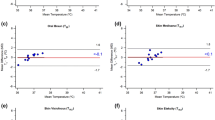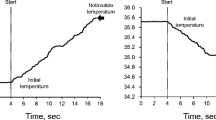Abstract
Effects of pressure exerted on the skin by elastic cord on the core temperature, body weight loss and salivary secretion rate were studied under conditions of ambient temperature of 35°C and a relative humidity of 60%. Twelve healthy females, aged 18–23 years, served as subjects. The subjects entered a bioclimatic chamber and rested quietly in a chair for 80 min. Then, skin pressure was exerted by applying elastic cord (8.5 mm wide) to six different skin areas, such as axilla, under-bust, waist, inguines, thighs and ankles. The values of skin pressure by elastic cord ranged from 11.9 to 33.3 g/cm2. In the control experiment, wrapping with an elastic cord was loosely performed without any skin pressure. Rectal and skin temperatures, body weight loss by sweating and salivary secretion rate were measured throughout the 160 min experimental period. Core temperature increased more significantly under pressure exerted on the skin. Body weight loss by mainly sweating and salivary secretion rate were significantly suppressed under pressure exerted on the skin. We discussed the physiological mechanisms in terms of suppression of central nervous activity as to why significant increase of core temperatures, inhibition of body weight loss mainly by sweating and of salivary secretion rate occurred, and furthermore practical significance of these findings for impairment of digestion, swallowing, vocalizing, defense against disease bacteria and sport activity.



Similar content being viewed by others
References
Emmelin N (1979) Interactions between sympathetic and parasympathetic nerves on the control of the salivary glands. In: Koizumi K, Sato A (eds) Integrative functions of the autonomic nervous system. Tokyo University Press, Tokyo, pp 5–23
Hirata K, Nagasaka T, Nonomura T, Hirai A, Hirashita M (1987) Effects of facial fanning on local exercise performance and thermoregulatory responses during hyperthermia. Eur J Appl Physiol 56:43–48
Jeong YO, Tokura H (1995) Effects of wearing two different clothing ensembles on endurance performance of handgrip exercise. J Human Ergol 24:25–31
Kosaka M, Takagi K, Koyama M (1967) Reflex inhibition of cold shivering by pressure in the skin and histological investigation of its afferent spinal pathway. Experientia 23:453–455
Kozłowski S, Brezezińska Z, Kruk B, Kaciuba-Uściłko H, Greenleaf JE, Nazer K (1985) Exercise hyperthermia as a factor limiting physical performance: temperature effect on muscle metabolism. J Appl Physiol 59:766–773
Kruk B, Kaciuba-Uściłko H, Nazer K, Greenleaf JE, Kozłowski S (1985) Hypothermic, rectal and muscle temperatures in exercising dogs: effects of cooling. J Appl Physiol 58:1444–1448
Kumazawa T (1963) “Deactivation” of the rabbit’s brain by pressure application to the skin. EEG Clin Neurophysiol 15:660–671
Lee YA, Hyun KJ, Tokura H (2000) The effects of skin pressure by clothing on circadian rhythms of core temperature and salivary melatonin. Chronobiol Int 17:783–793
Lee YA, Hyun KJ, Tokura H (2001) Circadian rhythm of core temperature and urinary noradrenaline secretion under the influence of skin pressure due to foundation garments worn during the wakefulness. Biol Rhythm Res 32:389–400
Mandel ID, Wotman S (1976) The salivary secretion in health and disease. Oral Sci Rev 8:25–47
Mitchell JW, Nadel ER, Stolwijk AJ (1972) Respiratory weight loss during exercise. J Appl Physiol 32:474–476
Ogawa T, Asayama M, Ito M, Yoshida K (1979) Significance of skin pressure in body heat balance. Jpn J Physiol 29:805–816
Okura K, Midorikawa-Tsurutani T, Tokura H (2000) Effects of skin pressure applied by cuffs on resting salivary secretion. J Physiol Anthoropol 19:107–111
Olshewski H, Brück K (1988) Thermoregulatory, cardiovascular and muscular factors related to exercise after precooling. J Appl Physiol 64:803–811
Schmidt V, Brück K (1981) Effects of a precooling maneuver on body temperature and exercise performance. J Appl Physiol 50:772–778
Tadaki E, Kumazawa T, Mizumura K, Takagi K (1981) Hemihidrosis due to skin pressure with particular remarks on the intensity and area of the pressure stimuli. Jpn J Physiol 31:259–267
Takagi K (1960) Influence of skin pressure on temperature regulation. In: Yoshimura H, Ogata K, Itoh S (eds) Essential problems in climatic physiology. Nankodo, Kyoto, pp 219–249
Tokura H, Komatsu Y, Tamura N (1983) Effects of pressure applied by clothing upon sweating rates in sedentary women. J Home Econ Jpn 34:633–637
Tsuchiya S (1953) The effects of skin pressure on the axillary temperature and gas exchange. Chapter 2: the effects of bilateral pressure on the body surface on the gas exchange and axillary temperature (in Japanese). Niigata Med J 67: 740–747
Ueki S (1954) Further studies on the body temperature changes due to skin pressure (in Japanese). J Jpn Soc Physiol 16:97–103
Yoneda S (1967) Clothing hygiene (in Japanese). Kagakudojin, Kyoto, p 146
Zhang P, Tokura H (1995) Effects of skin pressure by cuff on endurance performance and voluntary reaction time. Jpn J Clothing Res 38:37–41
Acknowledgement
The authors thank Dr. N. Shimojo, Tsukuba, Japan for his helpful comments, and Ms. E. Brejnakowska, Lodz, Poland for her kind corrections of our English text. The authors declare that the experiments comply with the current laws of Japan.
Author information
Authors and Affiliations
Corresponding author
Rights and permissions
About this article
Cite this article
Tanaka, S., Midorikawa, T. & Tokura, H. Effects of pressure exerted on the skin by elastic cord on the core temperature, body weight loss and salivary secretion rate at 35°C. Eur J Appl Physiol 96, 471–476 (2006). https://doi.org/10.1007/s00421-005-0099-z
Accepted:
Published:
Issue Date:
DOI: https://doi.org/10.1007/s00421-005-0099-z




